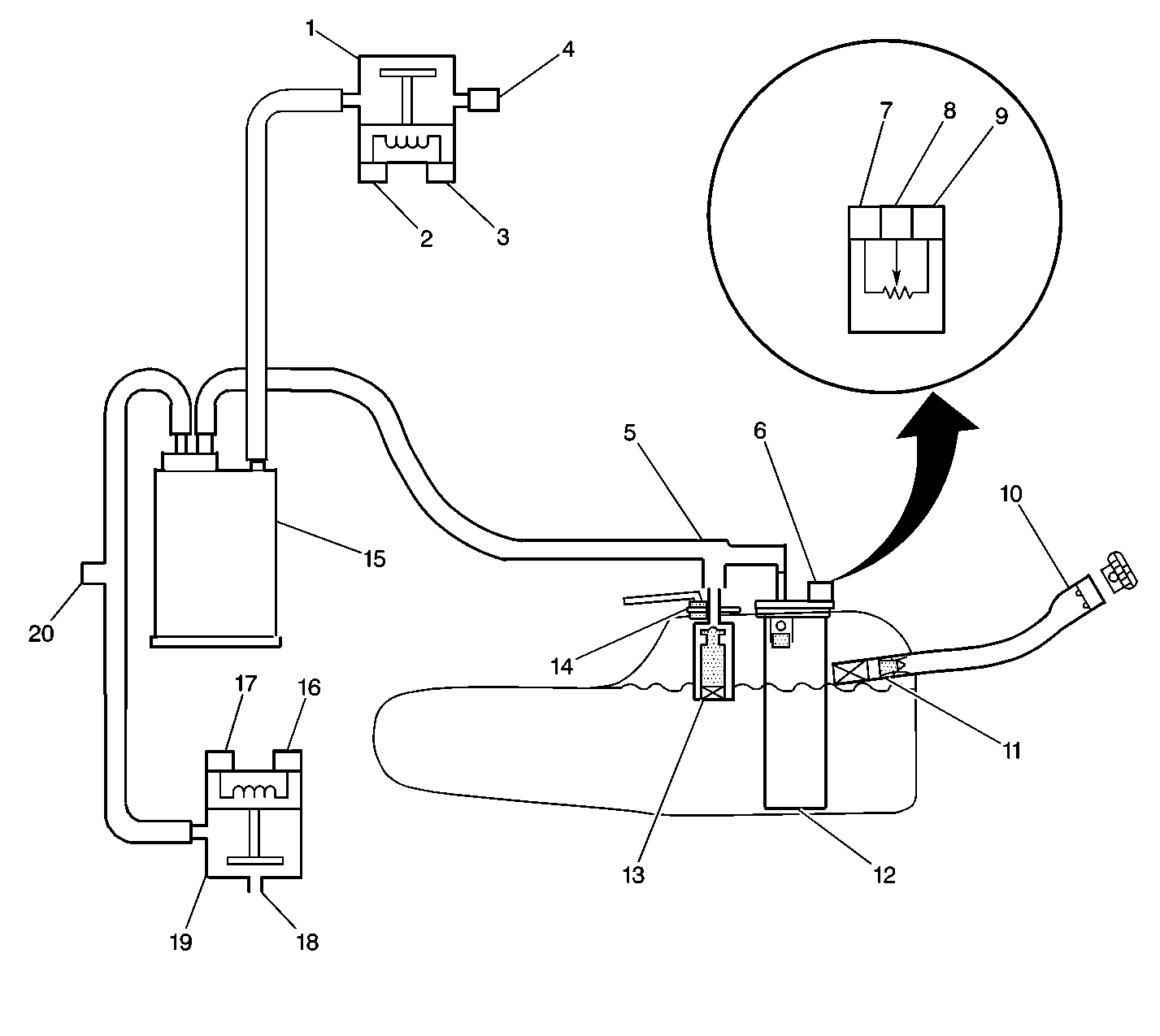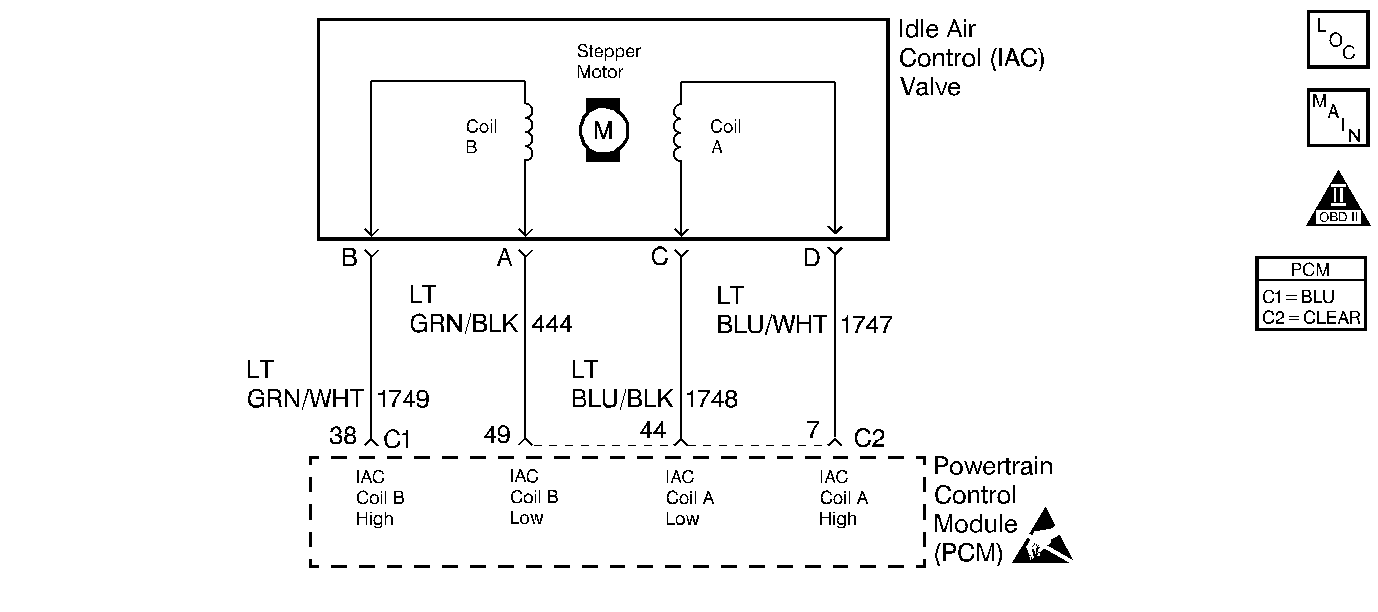The powertrain control module (PCM) controls the engine idle speed by
adjusting the position of the idle air control (IAC) motor pintle. The IAC
is a bi-directional motor that is driven by 2 coils. The PCM
pulses current to the IAC coils in steps, or counts, in order to extend
the IAC pintle into a passage in the throttle body in order to decrease the
air flow. This method allows highly accurate control of the idle speed,
and quick response to changes in the engine load.
Idle Air Control System Check
Step
| Action
| Value(s)
| Yes
| No
|
1
| Did you perform the On-Board Diagnostic (OBD) System Check?
| --
|
Go to Step 2
| Go to
Powertrain On Board Diagnostic (OBD) System Check
|
2
|
- Start the engine.
- Turn OFF all accessories, including the following:
| - | Other accessory components |
- Use a scan tool in order to command the RPM up to 1500, down to
650, and then up to 1500 while monitoring the engine speed on the scan tool.
Does the engine speed remain within the specified value of the desired
idle during each RPM command?
| ±50 RPM
| System OK
|
Go to Step 3
|
3
|
- Disconnect the IAC.
- Install a J 37027-A
IAC System Monitor.
- With the engine running, command RPM up to 1500, down to 650,
and then up to 1500 while observing the IAC System Monitor node lights.
Does each node light cycle red and green, but never OFF?
| --
|
Go to Step 5
|
Go to Step 4
|
4
|
- Check the following circuits for an open, for a short to voltage,
or for a short to ground:
- Repair any condition as necessary. Refer to
Wiring Repairs
in Wiring Systems.
Did you find a problem?
| --
|
Go to Step
12
|
Go to Step 10
|
5
| Did you
notice a low idle symptom or a rich condition?
| --
|
Go to Step 6
|
Go to Step 7
|
6
|
- Inspect for the following conditions:
| • | Throttle body tampering |
| • | A restricted air intake system |
| • | A collapsed air intake duct |
| • | A restricted air filter element |
| • | Foreign objects blocking the air intake system |
| • | Blockages of the throttle body from the following conditions: |
| - | Objects blocking the IAC passage or the throttle bore |
| - | Objects blocking the IAC pintle from fully extending |
| - | Excessive deposits in the IAC passage and on the IAC pintle |
| - | Excessive deposits in the throttle bore and on the throttle plate |
| - | A sticking throttle plate |
- Repair any condition as necessary.
Did you find a problem?
| --
|
Go to Step
11
|
Go to Step 8
|
7
|
- Inspect for the following conditions:
| • | Vacuum leaks-- Refer to Emissions Hose Routing Diagram
EVAP Control System Overview

|
| • | Throttle body tampering |
| • | Throttle plate or throttle shaft for binding |
- Repair any condition as necessary.
Did you find a problem?
| --
|
Go to Step
11
|
Go to Step 8
|
8
|
- Check for a poor connection at the IAC harness connector.
- Replace the faulty terminals as necessary. Refer to
Wiring Repairs
in Wiring Systems.
Did you find a problem?
| --
|
Go to Step
12
|
Go to Step 9
|
9
| Replace
the IAC valve. Refer to
Idle Air Control Valve Replacement
.
Is action complete?
| --
|
Go to Step
12
| --
|
10
|
- Check for a poor connection at the PCM harness connector.
- If you find a problem, replace the faulty terminals as necessary.
Refer to
Wiring Repairs
in Wiring
Systems.
Did you find a problem?
| --
|
Go to Step
12
|
Go to Step 11
|
11
|
Important: You must program the replacement PCM.
Replace the PCM. Refer to
Powertrain Control Module Replacement/Programming
.
Did you complete the replacement?
| --
|
Go to Step
12
| --
|
12
|
- Clear the DTCs.
- Start the engine.
- Turn OFF all accessories, including the air-conditioning and the
rear defroster
- Using a scan tool, command RPM up to 1500, down to 650, and then
up to 1500 while monitoring Engine Speed on the scan tool.
Does the engine speed remain within the specified value of the desired
idle for each RPM command?
| ± 50 RPM
| System OK
|
Go to Step 3
|


